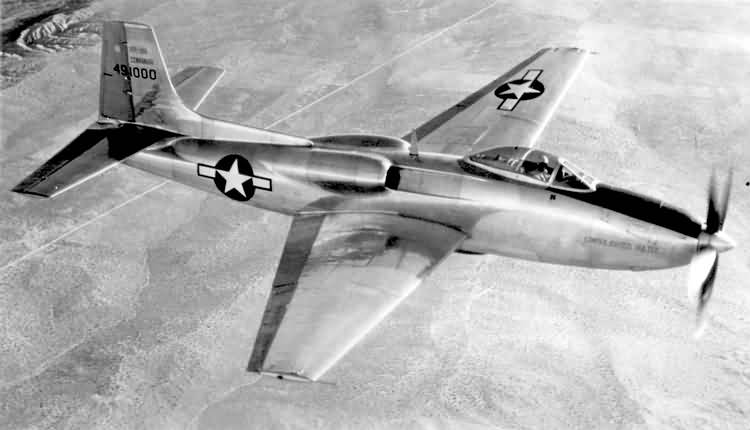01/15/2019. Remarks by Johan Visschedijk: "The first US propeller-turbine powered aircraft to fly, the single-seat Model 102 XP-81, was the result of a USAAF requirement issued in 1943 for a long-range fighter specifically for Boeing B-29 escort operations in the Pacific. The specification called for a twin-engined aircraft with a 1,250 mls (2,012 km) operating range, a ceiling of 37,000 ft (9,144 m), and a maximum speed of 500 mph (805 kmh).
In September, Convair's Vultee Division submitted a preliminary proposal using a 2,300 shp General Electric TG-100 (XT-31-GE-1) propeller-turbine in the nose, and an Allison-built 3,750 lb (1,701 kg) st General Electric I-40 (J33-GE-5) turbojet in the rear fuselage, fed by intakes shoulder-mounted on the rear fuselage. A closely-cowled annular intake for the TG-100 was located around the four-blade propeller spinner. The turboprop would be employed for cruising and the power of the turbojet being added for high-speed flight.
Detailed design work on the Model 102 began on January 5, 1944, six days later two XP-81 prototypes (serialed 44-91000 and 44-91001) were ordered, followed by an order for thirteen pre-production YP-81s. Chief engineer for the program was Charles R. 'Jack' Irvine, assisted by Chief Test Pilot Frank W. Davis.
The cockpit was designed to be pressurized from air bled from the TG-100 and the ejection seat was developed from that fitted to the XP-54. A thermal anti-icing system was installed and the nose wheel landing gear was electrically operated. Of all-metal construction, the XP-81 had heavy aluminum-alloy skin flush-riveted to the forward third of the NACA airfoil wing which incorporated two underwing hardpoints for 3,200 lb (1,452 kg) of bombs. Provision was made for six 0.50 in (12.7 mm) Browning M-2 machine guns, three in each wing, or six T-31 0.787 in (20 mm) cannon, or any combination thereof. Three fuel tanks behind the cockpit had a capacity of 752 gal (2,847 l) and with drop tanks, a total of 1, 468 gal (5,557 l) could be carried.
The first XP-81 was completed at Vultee's plant at Downey, California, in January 1945, but the TG-100 turboprop was suffering teething troubles and was not immediately available for installation. It was therefore suggested that a standard Packard Rolls-Royce Merlin piston-engine should be mounted in the nose for initial flight trials. A complete 1,490 hp V-1650-7 Merlin packaged power section (inclusive airscrew) for a P-51D Mustang was supplied by the USAAF. A special engine mount was made to pick up the Merlin attachment points and those in the XP-81 for the TG-100, the coolant radiator was placed in the position to have been occupied by the exhaust pipe of the turboprop, and a P-38J-style beard radiator inlet was prominent below the spinner. The necessary modifications were effected in little more than a week.
After ground tests, the XP-81 was sent to Muroc AAB (now Edwards AFB) where it was flown for the first time by Davis on February 11, 1945. Ten hours of flight testing were conducted at Muroc where the XP-81 evinced generally good handling characteristics, but directional stability was marginal. The second XP-81, still at the factory, was fitted with a 15 in ( 38 cm) rounded fin extension and a long ventral fin. The first XP-81 was eventually flown back to Vultee Field to be re-engined with the TG-100 turboprop.
In the mean time, the capture of Guam, Saipan and other Pacific islands removed the need for long-range, high-speed escort fighters, and shortly before V-J Day, when engineering was some 85% complete, the YP-81 contract was cancelled. The YP-81 was to have been essentially similar to the XP-81, apart from having the lighter and more powerful TG-110 turboprop in the nose, and the wing moved aft 10 in (25.4 cm).
Flight trials with the TG-100 turboprop equipped XP-81 were not resumed until four months after the cessation of hostilities, the initial test being made on December 21, 1945. The TG-100 was expected to offer 2,300 hp but in fact only achieved 1,650 shp. Although no details of the performance actually attained under test are available, reportedly the XP-81 was only 30 mph (48 kmh) faster than with the Merlin. Thus the XP-81 was only useful as a research vehicle, the first XP-81 also received the fin extension. However, propeller vibration and oil leaks were also a problem and after 69 flights totaling 42 hours with the propeller-turbine, the program ended on May 9, 1947.
Both prototypes were redesignated ZXF-81 in 1948, indicating research and development test beds, but it is believed that no further flying had taken place and the following year the airframes were stripped of useful parts. Placed on a photographic and bombing range at Edwards AFB, California, for many years, the remains were transferred to the Air Force Flight Test Museum at Edwards in 1994. By June 5, 2015, the remains were in storage at the National Museum of the USAF at Dayton, Ohio."
